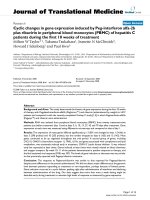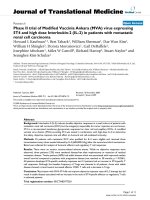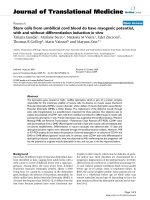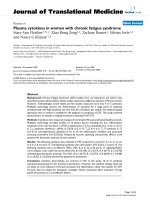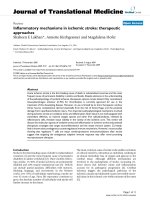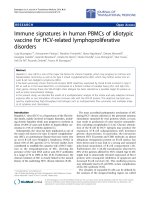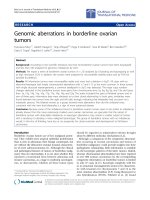báo cáo hóa học: " Genotoxic effects in occupational exposure to formaldehyde: A study in anatomy and pathology laboratories and formaldehyde-resins production" ppt
Bạn đang xem bản rút gọn của tài liệu. Xem và tải ngay bản đầy đủ của tài liệu tại đây (268.44 KB, 8 trang )
RESEARC H Open Access
Genotoxic effects in occupational exposure to
formaldehyde: A study in anatomy and pathology
laboratories and formaldehyde-resins production
Susana Viegas
1,3*
, Carina Ladeira
2,3
, Carla Nunes
3
, Joana Malta-Vacas
4
, Mário Gomes
5
, Miguel Brito
4
,
Paula Mendonça
2
, João Prista
6
Abstract
Background: According to the Report on Carcinogens, formaldehyde ranks 25
th
in the overall U.S. chemical
production, with more than 5 million tons produced each year. Given its economic importance and widespread
use, many people are exposed to formaldehyde environmentally and/or occupationally. Presently, the International
Agency for Research on Cancer classifies formaldehyde as carcinogenic to humans (Group 1), based on sufficient
evidence in humans and in experimental animals. Manyfold in vitro studies clearly indicated that formaldehyde can
induce genotoxic effects in proliferating cultured mammalian cells. Furthermore, some in vivo studies have found
changes in epithelial cells and in peripheral blood lymphocytes related to formaldehyde exposure.
Methods: A study was carried out in Portugal, using 80 workers occupationally exposed to formaldehyde vapours:
30 workers from formaldehyde and formaldehyde-based resins production factory and 50 from 10 pathology and
anatomy laboratories. A control group of 85 non-exposed subjects was considered. Exposure assessment was
performed by applying simultaneously two techniques of air monitoring: NIOSH Method 2541 and Photo Ionization
Detection equipment with simultaneously video recording. Evaluation of genotoxic effects was performed by
application of micronucleus test in exfoliated epithelial cells from buccal mucosa and peripheral blood
lymphocytes.
Results: Time-weighted average concentrations not exceeded the reference value (0.75 ppm) in the two
occupational settings studied. Ceiling concentrations, on the other hand, were higher than reference value (0.3
ppm) in both. The frequency of micronucleus in peripheral blood lymphocytes and in epithelial cells was
significantly higher in both exposed groups than in the control group (p < 0.001). Moreover , the frequency of
micronucleus in peripheral blood lymphocytes was significantly higher in the laboratories group than in the factory
workers (p < 0.05). A moderate positive correlation was found between duration of occupational exposure to
formaldehyde (years of exposure) and micronucleus frequency in peripheral blood lymphocytes (r = 0.401;
p < 0.001) and in epithelial cells (r = 0.209; p < 0.01).
Conclusions: The population studied is exposed to high peak concentrations of formaldehyde with a long-term
exposure. These two aspects, cumulatively, can be the cause of the observed genotoxic endpoint effects. The
association of these cytogenetic effects with formaldehyde exposure gives important information to risk
assessment process and may also be used to assess health risks for exposed workers.
* Correspondence:
1
Environmental Health Department. Escola Superior de Tecnolo gia da Saúde
de Lisboa - Instituto Politécnico de Lisboa. Lisbon, Portugal
Full list of author information is available at the end of the article
Viegas et al . Journal of Occupational Medicine and Toxicology 2010, 5:25
/>© 2010 Viegas et al; licensee BioMed Central Ltd. This is an Open Access article distributed under the terms of the Creative Commons
Attribution License ( ), which permits unrestricted use, distribution, and reproduction in
any medium, provided the original work is properly cited.
Background
Formaldehyde (CH
2
O), the most simple and reactive of
all aldehydes, is a colorless, reactive and readily poly-
merizing gas at room temperature [1]. It has a pungent
suffocating odor t hat is recogni zed by most human sub-
jects at concentrations below 1 ppm [2].
According to the Report on Carcinogens, formalde-
hyde (FA) ranks 25
th
in the overall U.S. chemical pro-
duction, with more than 5 million tons produced each
year [3]. FA annual production rises up to 21 million
tons worldwide and it has increased in China, for exam-
ple, i n the recent years, with 7,5 million tons produced
in 2007. Given its economic importance and widespread
use, many people are exposed to FA environmentally
and/or occupationally [ 4]. According to the Inter-
nat ional Infor mat ion System on Occupational Exposure
to Carcinogens (CAREX), in the period between 1990
and 1993, 36,000 workers were occupationally exposed
to FA in Portugal [5].
Occupational exposure involves not only workers in
direct production of FA and products containing it, but
also in industries utilizing these products, such as those
related with construction and household [1]. The most
extensive use of FA is in production of resins with urea,
phenol and melamine, and also polyacetal resins. These
products are used as adhesives in manufacture of parti-
cle-board, plywood, furniture and other wood products
[2]. FA is also used in cosmetics composition and has
an important application as a disinfectant and preserva-
tive, reason why relevant workplace exposure may also
occur in pathology and anatomy laboratories and in
mortuaries [1,2,6].
Human studies have shown t hat chronic exposure to
FA by inhalation is associated with eye, nose and throat
irritation [7]. Mostly important, several studies report a
carcinogenic effect in humans after chronic exposure to
FA, in particular an i ncreased risk for nasopharyngeal
cancer [8-12]. Since 2006, International Agency for
Research on Cancer (IARC) classifies FA as carcinogenic
to humans (Group 1), based on sufficient evidence in
humans and in experimental animals [2]. IARC also
concluded that there is a “strong bu t not sufficient evi-
dence for a c ausal association between leukemia and
occupational exposure to formaldehyde”.
With actual scientific evidence we can conclude that,
regarding to risk estimation, local toxic effects at site of
first contact seem to be the most relevant health effects
[2,7,13].
Manifold in vitro studies clearly indicated that FA can
induce genotoxic effects in proliferating cultured mam-
malian cells [2]. Furthermore, some in vivo studies
detected changes in epithelial cells (oral and nasal) and in
peripheral lymphocytes related to FA exposure [13,14].
Frequency of micronucleus (MN) in buccal and/or
nasal mucosa cells is being used to investigate local gen-
otoxicity. According to reports concerning experimental
genotoxicity studies, MN are the most sensitive genetic
endpoints for detection of FA induced genotoxicity [15].
Thus, MN test with exfoliated cells could be a powerful
tool for detection of local genotoxic effects in humans,
which is fundamental for hazard identification and risk
estimation [13].
MN in peripheral blood lymphocytes has been exten-
sively used to evaluate the presence and extend of chro-
mosome damage in human po pulations exp osed to
genotoxic age nts. As advantages, this MN test provides
a reliable measure of chromosomal breakage and loss at
lower cost and more easily than chromosomal aberra-
tions. Moreover, the availability of cytokinesis-block
technique eliminates potential background caused by
effects on cell division kinetics [16].
The goal of this study is to contribute to the investiga-
tion of genotoxic effects in workers occupationally
exposed to FA.
Methods
Subjects
This study was carried out in Portugal, in 80 workers
occupationally exposed to FA vapors: 30 work ers from
FA and FA-based resins produ ction factory and 50 from
10 pathology and anatomy l aboratories. A control group
of 85 non-exposed subjects was consi dered. All subjects
were provided with the protocol and with the consent
form, which they read and signed.
Health conditions, medical history, medication and
lifestyle factors for all studied individuals, as well as
information related to working practices (such as years
of employment) were obtained through a standard
questionnaire.
Environmental Monitoring of FA exposure
Exposure assessment was performed by applying simul-
taneously two different methods.
In one of the methods, environmental samples were
obtained by personal a ir sampling with low flow pumps
during a typical working day. Sampling time was 6 to 8
hours. FA levels were measured by Gas Chromatography
(GC) analysis and time-weighted average (TWA
8h
) es ti-
mated according to the National Institute of Occupa-
tional Safety and Health method (NIOSH 2541) [17].
The other method was aimed to measure ceiling
values of FA using Photo Ionization Detection (PID)
equipment (11.7 eV lamps) with simultaneously video
recording. Measures were performed in each task and
instantaneous values for concentration were obtained on
a per second basis. This method permits to establish a
Viegas et al . Journal of Occupational Medicine and Toxicology 2010, 5:25
/>Page 2 of 8
relation between worker activities and ceiling values and
allows also determining the major emission sources [18].
Micronucleus Test
Evaluation of genotoxic effects was performed by appli-
cation of MN test in exfoliated cells from buccal mucosa
and peripheral blood lymphocytes. Heparinized venous
blood and exfoliated cells (buccal mucosa cells) were
collected between 10 a.m. and 12 p.m., from each sub-
ject, and were processed for each test. All samples were
coded and analyzed under blind conditions. The criter-
ion of scoring the M N in lymphocytes is described in
“The Human Micronucleus Project” and the buccal cells
is described by Tolbert et al. [19,20].
Buccal mucosa micronucleus test
Endobrush was used to collect cells from the buccal
mucosa. Exfoliated c ells were smeared onto the slides
and fixed with Mercofix®. The standard protocol used
was Feulgen staining technique without counterstain.
Two thousand cells were scored from each individual by
four independent observers. Only cells containing intact
nuclei that were not clumped or overlapped were
included in the analysis.
Peripheral Lymphocyte micronucleus test
From each subject a blood specimen (10 mL) was col-
lected using he parin as anticoagulant. The samples were
kept refrigerated and processed within 6 hours of the
blood collection. Lymphocytes were isolated using
Ficoll-Paque gradient and pla ced in RPMI 1640 culture
medium with L-glutamine and phenol red added w ith
10% inactivated fetal calf serum, 50 μg/mL streptomycin
+ 50 U/mL penicillin and 10 μ g /mL phytohaemaggluti-
nin. Duplicate cultures from each subject were incu-
bated at 37°C in a humidified 5% CO
2
incubator for 44
hours. Cytochalasin-b 6 μg/mL was ad ded to cu ltures.
After 28 hours o f incubation, cells were spun onto
microscope slides using a cytocentrifuge. Smears were
air-dried and double stained with May-Grünwald-
Giemsa and mounted with Entellan®.
A total of 1000 binucleated cells with well-pre served
cyt oplasm were examined for each donor. The frequen-
cies of binucleated cells with MN were determined ana-
lyzing 1,000 binucleate lymphocytes from two slides for
each subject.
Statistical Analysis
Differences between groups (exposed workers and con-
trols) were analyzed w ith t-Student and Proportion
tests, in order to evaluate if basic characteristics of these
2 groups could be considered equivalent [20].
Association between quantitative variables was tested
using correlation coefficient tests (Pearson or Spearm an
according with their probability distributions). Statistical
analysis was performed with SPSS for Windows statisti -
cal package, version 17.0, and significance level was
defined as 5%, for all inference studies.
Results
Characteristics of the studied population
The characterization of the po pulation studied is su m-
marized in Table 1. Controls and exposed workers did
not differ significantly in age and in smoking habits.
Only for gender distribution a significant difference was
found between the two groups (p = 0.002), due to the
larger number of women in the control group.
None of the individuals presented relevant information
about health conditions, medical history, medication and
lifestyle factors that could infl uence the results of MN
test.
FA exposure levels
FA exposure levels obtained by two methods (NIOSH
2541 for average concentrations - TWA
8h
and Photo
Ionization Detection method for ceiling concentrations -
C) are shown in Table 2.
Time-weighted average concentrations (TWA
8h
) have
not exceeded the Occupati onal Safety and Health
Administration (OSHA) reference value (0.75 ppm). On
the other hand, ceiling conc entrations were higher than
American Conference of Industrial Hygienists (ACGIH)
reference value (0.3 ppm) in both occupational settings.
Mean FA ceiling levels are higher in pathology and
anatomy laboratories t han in resins factory. In this set-
ting, 83 tasks were studied and highest exposure level
was observed during macroscopic examination of FA-
preserved specimens. Moreover, 93% of studied tasks
obtained ceiling levels higher than reference value
(0.3 ppm). Pathologists wer e the professional group
Table 1 Characterization of the studied population
Control Group Exposed Group P value
Number of subjects 85 80
Gender
Male 31 (36.6%) 48 (60.0%) 0.002
Female 54 (63.5%) 32 (40.0%)
Age (years)
Range 20-55 19-56
Mean 33.87 35.74 0.180
St. Deviation 8.262 9.470 0.024
Smoking status
Non-smokers 59 (69.4%) 55 (68.8%) 0.927
Smokers 26 (30.6%) 25 (31.3%)
Years of exposure
Range ———— 1-35
Viegas et al . Journal of Occupational Medicine and Toxicology 2010, 5:25
/>Page 3 of 8
exposed to the highest c eiling concentration values
(Table 3).
Exposure has been studied in normal conditions
of operation, namely with ventilation dispositives
connected and workers not using protective masks.
Micronucleus Test
The frequency of MN in occupationally exposed work-
ers was significantly higher than in the control group,
both in peripher al blood lymphocytes (p < 0.001) and in
epithelial buccal cells (p < 0.001) (Table 4).
When analyzing each occupational setting separately,
we found significan t differences in MN frequencies in
peripheral blood lymphocytes (p < 0.001) and in epi the-
lial buccal cells (p < 0.005) between the laboratories and
control groups. Concerning the factory group, significant
differences in MN frequencies were only detected in
epithelial buccal cells (p < 0.001).
Finally, we compared MN frequencies between the
two exposed groups and found that MN frequency in
peripheral blood lymphocytes was significantly higher in
the laboratories group (p < 0.005), but respecting to
epithelial buccal cells ther e was no significant difference
between them (p = 0.108).
There was no significant difference in the frequency of
MN, both in epithelial cells and peripheral lymphocyte
tested for smoking habits (p =0.31;p =0.99)andfor
gender (p = 0.13; p = 0.47).
Age was found to have a weak positive correlation (r =
0.194; p < 0.05) with MN frequency in peripheral blood
lymphocytes and a week nega tive correlation (r=-0.168;
p < 0.05) with MN frequency in epithelial cells. A mod-
erate positive correlation was found between duration of
occupational exposure to FA (years of exposure) and
frequency of MN in peripheral blood lymphocytes
(r = 0.401; p < 0.05) and in epithelial cells (r = 0.209;
p < 0.05) (Table 5).
There was no significant difference (p >0.05)inthe
frequency of MN in both peripheral blood lymphocytes
and e pithelial cells tested for smoking habits (p =0.31;
p = 0.99) and for gender (p = 0.13; p = 0.47).
Discussion
As indicated by several studies [6,21,22] exposure assess-
ment in present investigation identified that both groups
of workers (factory and laboratory) were exposed to
high peak FA concentrations.
The importance of this consideration lies in the fact
that health effects (cancer) linked to FA exposure are
more related with peaks of high c oncentrations than
with long time exposure at low levels [2,23]. The choice
of exposure metric should be based on the most biologi-
cally relevant exposure meas ure in order to diminish
misclassification of exposure, thus leading to attenuated
exposure-response relationships [24]. Moreover, expo-
sures of short duration (peaks) are of special concern,
because they pr oduce an elevated dose rate at target tis-
sues and organs, potentially altering metabolism, over-
loading protective and repair mechanisms and
amplifying tissue responses [24,25].
Considering this, Pyatt et al. (2008) pointed out, as a
limitation in most epidemiological studies, the lack of
data about exposure t o peak concentrations. Therefore,
in those studies, health effects resulting from
Table 2 FA exposure in the two occupational settings
Factory Laboratories
Exposure duration (Years)
Range 1 - 27 1 - 33
Mean 6.2 14.5
St. Deviation 6.74 9.12
Working hours/day (h) 7 7
Number of Samples (TWA measures) 2 29
FA exposure level (TWA
8h
) (ppm)
Range 0.20 - 0.22 0.05 - 0.51
Mean 0.21 0.28
FA ceiling concentration (ppm)
Range 0.003 - 1.04 0.02 - 5.02
Mean 0.52 2.52
Table 3 FA Ceiling values (ppm) according to places of work, tasks and exposed workers
Places of work Tasks Ceiling Values (ppm) Exposed Workers
Factory Resins production Sample collect (Reactors) 1.09 Reactor operators
Factory Impregnation Machine operation 1.04 Impregnation machine operators
Factory Quality Laboratory Quality control 0.52 Quality Technicians
Pathology and anatomy laboratories Macroscopic examination 5.02 Pathologist
Pathology and anatomy laboratories Disposal of specimen and used solutions 0.95 Technicians and Assistants
Pathology and anatomy laboratories Jar filling 2.51 Assistants
Pathology and anatomy laboratories Specimen wash 2.28 Technicians
Pathology and anatomy laboratories Biopsy 1.91 Technicians
Viegas et al . Journal of Occupational Medicine and Toxicology 2010, 5:25
/>Page 4 of 8
occupational exposure to FA are associated to exposure
exclusively based on time-weighted average concentra-
tions [23]. The only two studi es concerning the associa-
tion between exposure to FA and nasopharyngeal cancer
that presented data on exposure to ceiling concentra-
tions obtained higher relative risk values compared with
the other studies [1,12,26].
Moreover, other groups also suggested ceiling concen-
trations as the most important exposure metric, when
attempting to define the relative risk of myeloid leukae-
mia in workers exposed to FA [1,27-29].
The present results obtained in the laboratories, evi-
dence a difference between the two exposure metrics
(0.28 ppm for TWA
8h
and 2.52 ppm for ceiling level).
These resul ts are in good agree ment with previ ous ones
reported by Shaham et al. [30]. A difference of the same
order of magnitude was described in 14 pathology
laboratories (0.4 ppm for TWA and 2.24 ppm for ceiling
level).
Each one of these results would lead to different con-
clusions about exposure assessment and, consequently,
to a different risk assessment and, though, claim our
attention for the importance of exposure metric selec-
tion. For FA occupational ex posure, ceiling concentra-
tions might be a better strategy to evaluate exposure
and to develop risk assessment once very high exposures
over short periods are missed by TWA
8h
method and,
in fact, they are important to know the real risk for
health [23,31]. Therefore, as in other investigations
[33,34], it is pos sible to conclude that when measuring
only TWA
8h
poor information is obtained, and the
method is of less utility to identify processes that should
be targeted for controls.
Results indicate macroscopic examination of anatomi-
cal specimens FA-preserved as the task involving expo-
sure to the highest values. This occurs because precision
and good visibility is required and as a consequence
pathologists must lean over the specimen with conse-
quent increase of proximity to FA emission sources.
Studies developed by Goyer et al. and Orsière et al. sup-
port that proximity to impregnated specimens promotes
higher exposure to FA [6,22].
In factory, the task of collecting samples from resins
reactor present the higher exposure, because the reac-
tors are consider the units withlargeremissions[6,32].
Furthermore, the sampling process is still manual in the
factory studied.
It is important to notice that the information about
exposure determinants, emission sources and exposed
workers was only possible because video recording
could be performed. Thi s resource gives the opportunity
to directly relate performance with exposure [18,35,36].
FA genotoxicity is confirmed in a variety of experi-
mental systems ranging from ba cteria to rodent s in vivo
[37]. Although the findings from in vivo animal studies
may provide a basis for extrapolation to humans, cyto-
genetic assays in humans have been conflicting, some-
times with contradictory outcomes [38]. Nevertheless,
our results showed a significant increase in MN fre-
quency in epithelial cells and in lymphocytes of exposed
individuals compared with controls.
Biological evidence of toxicity on distant-site such as
peripheral lymphocytes and bone marrow is still contro-
versia l [2,39]. Some auth ors have argued that it is biolo-
gically implausible for FA to cause leukaemia a s FA is
unlikely to reach the bone marrow and cause toxicity.
Due to its highly reactive nature and rapid metabolism,
there is no evidence that it can damage stem and pro-
genitor cells (the target cells for leukemogenesis). Also,
there is no credible experimental animal model for FA-
induced leukaemia [40,41]. However, Zhang et al.
hypothesize that FA may act on bone m arrow directly
or, a lternatively, may cause leukaemia by damaging the
hematopoietic stem or early progenitor cells that are
Table 4 Frequency of MN in the studied population
Controls Exposed
Factory Pathology and anatomy laboratories Total
MN PBL
1
Mean ± Std. Dev 1.17 ± 1.95 1.76 ± 2.07 3.70 ± 3.86 2.97 ± 3.42
MN EBC
2
Mean ± Std. Dev 0.13 ± 0.48 1.27 ± 1.55 0.64 ± 1.74 0.88 ± 1.69
1
peripheral blood lymphocytes (cytochalasin-B (binucleated) assay
2
epithelial buccal cells
Table 5 Correlation analysis between genotoxic
endpoints and age and years of exposure (Spearman’s
test)
Genotoxic endpoints Age Years of Exposure
r = 0.194 r = 0.401
MN PBL
1
p = 0.013 p = 0.0
r = - 0.168 r = 0.209
MN EBC
2
p = 0.031 p = 0.008
1
peripheral blood lymphocytes (cytochalasin-B (binucleated) assay)
2
epithelial buccal cells
Viegas et al . Journal of Occupational Medicine and Toxicology 2010, 5:25
/>Page 5 of 8
located in the circulating blood or nasal passages, which
would then travel to bone marrow and become leukemic
stem cells [1,29]. Nevertheless, our findings are consis-
tent with other previous studies on epithelial cells and
also on peripheral lymphocytes [42-44]. Suruda et al.
reported that low-level exposure t o FA was associated
with cytogenetic changes in buccal epithelial cells and in
blood lymphocytes in mortician students [14]. Our
results in blood lymphocytes can be an indication that
cytogenetic effects can be found in t issues distant from
the area of initial contact (nasopharyngeal) and even
reach the bone marrow and cause toxicity, supporting
the thesis of Zhang and colleagues [1,29].
A significant positive correlation between MN fre-
quency (both in peripheral blood lymphocytes and in
epithelial buccal cells) and the duration of FA exposure
(years of employment) was found (Table 4). This indi-
cates that, together with peak contacts, exposure dura-
tion also has relevance for the development o f health
effects. Furthermore, in our study, long-term exposure
to high levels of FA was n oted particularly in pathology
and anatomy laboratory workers (exposure duration
mean of 14.5 years), fact that may at least contribute to
expl ain the higher frequency of M N in peripheral blood
lymphocytes in this group when compared to the factory
group (Table 4). Regarding the influence of age, a posi-
tive correlation was found with MN frequency in per-
ipheral blood lymphocytes (Table 5). MN frequencies
tend to rise with age because of the progressive in crease
in spontaneous chromosome instability and the loss of
efficiency in DNA repair mechanism s, which may result
in accumulation of genetic lesions with increasing age
[22,45]. On the other hand, for MN frequency in epithe-
lial buccal cells, a negative correlation was found (Table
5).Thiscanpossiblybeexplainedbythefactthatcells
of buccal mucosa have a steady and rapid turnover, and
therefore accumulation of genotoxic effects becomes dif-
ficult [13].
No significant diff erences were obtaine d in MN fre-
quencies between women and men (both in peripheral
blood lymphocytes and epithelial buccal cells). However,
in other studies an increase in MN frequencies in
women was found. Current knowledge on the effect of
gen der on genetic damage determines a 1.5-fold greater
MN frequency in females than in males [19,45], witch
can be explained by pre ferential aneugenic events invol-
ving the X-chromossome. Surralés et al. reported an
excessive overrepresentation of this chromosome in
micronucleic lymphocytes cultured from women [46].
Tobacco smoke contains a high number of mutagenic
and carcinogenic substances and is causally linked to an
elevated incidence o f several forms of cancers [47].
Hence, smoking is an important variable to consider in
biomonitoring studies and, particularly in this study
since FA is present in tobacco smoke [2]. The effect o f
tobacco smoking on MN frequency in human cel ls has
been object of study. In most reports the results w ere
unexpected, as in many instance smokers had lower fre-
quencies of MN than non-smokers [22,48]. In the pre-
sent study no significant differences were found in M N
(peripheral blood lymphocytes and epithelial buccal
cells) between smokers and non-smokers. These findings
are similar to results obtained in th e study of Bona ssi et
al., [48]. These authors recommend that quantitative
data about smoking habit should be collected because
the sub-group of heavy smokers (≥ 30 cigarettes per day)
can influence the results. For notice, the questionnaire
results of this study revealed no heavy smokers in these
workers groups.
Conclusions
In conclusion, the population studied is exposed to high
ceiling concentrations (peaks) of FA with a long-term
exposure. These two aspects, cumulatively, can be the
cause for the increase in MN frequencies in lymphocytes
and in epithelial buccal cells.
Results obtained suggest that preventive and protec-
tive measures must be applied in order to reduce occu-
pational exposure to this chemical agent in these two
occupational settings and, subsequently, to prevent
adverse effects on workers health.
Acknowledgements
This work was supported by Portuguese Authority for Work Conditions (ACT:
Project reference: 075MNA/06.
Author details
1
Environmental Health Department. Escola Superior de Tecnolo gia da Saúde
de Lisboa - Instituto Politécnico de Lisboa. Lisbon, Portugal.
2
Anatomy and
Pathology Department. Escola Superior de Tecnologia da Saúde de Lisboa -
Instituto Politécnico de Lisboa. Lisbon, Portugal.
3
CIESP - Centro de
Investigação e Estudos em Saúde Pública (ENSP/UNL) ENSP - Escola Nacional
de Saúde Pública - Universidade Nova de Lisboa. Lisbon, Portugal.
4
Biology
Department. Escola Superior de Tecnologia da Saúde de Lisboa - Instituto
Politécnico de Lisboa. Lisbon, Portugal.
5
Chemistry Department. Escola
Superior de Tecnologia da Saúde de Lisboa - Instituto Politécnico de Lisboa.
Lisbon. Portugal and REQUIMTE/CQFB, Faculty of Sciences and Technology,
Universidade Nova de Lisboa and SINTOR-UNINOVA, Monte de Caparica,
Portugal.
6
Environmental and Occupational Health Department and CIE SP -
Centro de Investigação e Estudos em Saúde Pública (ENSP/UNL) ENSP -
Escola Nacional de Saúde Pública - Universidade Nova de Lisboa. Lisbon,
Portugal.
Authors’ contributions
SV conceived the idea and designed the study, and developed also
formaldehyde exposure assessment. CL, PM, JMV and MB performed the MN
tests. MG developed chemical analysis. CN performed the statistical data
analyses. JP contributed to the study design and coordination. All authors
have read and approved the final manuscript.
Competing interests
The authors declare that they have no competing interests.
Received: 5 April 2010 Accepted: 20 August 2010
Published: 20 August 2010
Viegas et al . Journal of Occupational Medicine and Toxicology 2010, 5:25
/>Page 6 of 8
References
1. Zhang L, Steinmaus C, Eastmond DA, Xin XK, Smith MT: Formaldehyde
exposure and leukemia: A new meta-analysis and potential mechanisms.
Mutat Res 2009, 681:150-168.
2. International Agency for Research on Cancer: Formaldehyde, 2-
Butoxyethanol and 1-tert-Butoxypropan-2-ol. Lyon: IARC 2006.
3. National Toxicology Program (NTP): Formaldehyde (Gas) CAS no. 50-00-0,
2005: report on carcinogens [Em linha] Washington, DC: National Institutes of
Health, 11 2005 [ />pdf].
4. Nazaroff W, Coleman BK, Destaillats H, Hodgson AT, Liu D, Lunden MM,
Singer BC, Weschler CJ: Indoor air chemistry: cleaning agents, ozone and toxic
air contaminants Berkeley, CA: Air Resources Board, California Environmental
Protection Agency 2006.
5. Kauppinen T, Toikkanen J, Pedersen D, Young R, Ahrens W, Boffetta P,
Hansen J, Kromhout H, Maqueda Blasco J, Mirabelli D, de la Orden-Rivera V,
Pannett B, Plato N, Savela A, Vincent R, Kogevinas M: Occupational
exposure to carcinogens in the European Union. Occup Environ Med
2000, 57:10-8.
6. Goyer N, Beaudry C, Bégin D, Bouchard M, Buissonnet S, Carrier G, Gely O,
Gérin M, Lavoué J, Lefebvre P, Noisel N, Perrault G, Roberge B: Impacts d’un
abaissement de la valeur d’exposition admissible au formaldéhyde: industries
de fabrication de formaldéhyde et de résines à base de formaldéhyde
Montréal: Institut de Recherche Robert-Sauvé en Santé et en Sécurité du
Travail 2004.
7. Herausgegeben von AS, Bernauer U, Madle S, Mielke H, Herbst U, Richter-
Reichhelm HB, Appel KE, Gundert-Remy U: Assessment of the carcinogenicity
of formaldehyde (CAS No. 50-00-00) Berlim: Bundesinstitut für
Risikobewertung 2006.
8. Armstrong RW, Imrey PB, Lye MS, Armstrong MJ, Yu MC, Sani S:
Nasopharyngeal carcinoma in Malaysian Chinese: occupational
exposures to particles, formaldehyde and heat. Int J Epidemiol 2000,
29:991-998.
9. Vaughan TL, Stewart PA, Teschke K, Lynch CF, Swanson GM, Lyon JL,
Berwick M: Occupational exposure to formaldehyde and wood dust and
nasopharyngeal carcinoma. Occup Environ Med 2000, 57:376-384.
10. Hildesheim A, Dosemeci M, Chan CC, Chen CJ, Cheng YJ, Hsu MM, Chen IH,
Mittl BF, Sun B, Levine PH, Chen JY, Brinton LA, Yang CS: Occupational
exposure to wood, formaldehyde, and solvents and risk of
nasopharyngeal carcinoma. Cancer Epidemiol Biomarkers Prev 2001,
10:1145-1153.
11. Coggon D, Harris EC, Poole J, Palmer KT: Extended follow-up of a cohort
of British chemical workers exposed to formaldehyde. J Natl Cancer Inst
2003, 95:1608-1615.
12. Hauptmann M, Lubin JH, Stewart PA, Hayes RB, Blair A: Mortality from solid
cancers among workers in formaldehyde industries. Am J Epidemiol 2004,
159:1117-1130.
13. Speit G, Schmid O: Local genotoxic effects of formaldehyde in humans
measured by the micronucleus test with exfoliated cells. Mutat Res 2006,
613:1-9.
14. Suruda A, Schulte P, Boeniger M, Hayes RB, Livingston GK, Steenland K,
Stewart P, Herrick R, Douthit D, Fingerhut MA: Cytogenetic effects of
formaldehyde exposure in students of mortuary science. Cancer
Epidemiol Biomarkers Prev 1993, 2:453-460.
15. Merk O, Speit G: Significance of formaldehyde-induced DNA-protein
crosslinks for mutagenesis.
Environ Mol Mutagen 1998, 32:260-268.
16. Bonassi S, Fenech M, Lando C, Lin YP, Ceppi M, Chang WP, Holland N,
Kirsch-Volders M, Zeiger E, Ban S, Barale R, Bigatti MP, Bolognesi C, Jia C, Di
Giorgio M, Ferguson LR, Fucic A, Lima OG, Hrelia P, Krishnaja AP, Lee TK,
Migliore L, Mikhalevich L, Mirkova E, Mosesso P, Müller WU, Odagiri Y,
Scarffi MR, Szabova E, Vorobtsova I, Vral A, Zijno A: Human MicroNucleus
Project: international database comparison for results with the
cytokinesis-block micronucleus assay in human lymphocytes: I. Effect of
laboratory protocol, scoring criteria, and host factors on the frequency
of micronuclei. Environ Mol Mutagen 2001, 37:31-45.
17. National Institute for Occupational Safety and Health (NIOSH) -
Formaldehyde: method 2541 Cincinnati, OH: NIOSH, 4 1994, 2.
18. Mcglothlin J, Xu F, Vosciky J: Occupational exposure assessment and
control using video exposure monitoring in the pharmaceutical industry.
Proceedings of the International Scientific Conference IOHA 2005: 19-23
September South Africa 2005.
19. Fenech M, Chang WP, Kirsch-Volders M, Holland N, Bonassi S, Zeiger E:
HUman MicronNucleus project: HUMN project: detailed description of
the scoring criteria for the cytokinesis-block micronucleus assay using
isolated human lymphocyte cultures. Mutat Res 2003, 534:65-75.
20. Dawson B, Trapp R: Basic and clinical biostatistics MacGraw-Hill Medical
1994.
21. Shaham J, Bomstein Y, Gurvich R, Rashkovsky M, Kaufman Z: DNA-protein
crosslinks and p53 protein expression in relation to occupational
exposure to formaldehyde. Occup Environ Med 2003, 60:403-409.
22. Orsière T, Sari-Minodier I, Iarmarcovai G, Botta A: Genotoxic risk
assessment of pathology and anatomy laboratory workers exposed to
formaldehyde by use of personal air sampling and analysis of DNA
damage in peripheral lymphociytes. Mutat Res 2006, 605:30-41.
23. Pyatt D, Natelson E, Golden R: Is inhalation exposure to formaldehyde a
biological plausible cause of lymphohematopoietic malignancies? Regul
Toxicol Pharmacol 2008, 51:119-133.
24. Preller L, Burstyn I, De Pater N, Kromhout H: Characteristics of Peaks of
Inhalation Exposure to Organic Solvents. Ann Occup Hyg 2004, 48:643-652.
25. Smith T: In Studying peak exposure: toxicology and exposure statistics. Edited
by: Marklund S. Stockholm: National Institute for Working Life; 2001:207-209,
X2001 - Exposure assessment in epidemiology and practice
26. Pinkerton LE, Hein MJ, Stayner LT: Mortality among a cohort of garment
workers exposed to formaldehyde: an update. Occup Environ Med 2004,
61:193-200.
27. Collins JJ, Lineker GA: A review and meta-analysis of formaldehyde
exposure and leukemia. Regul Toxicol Pharmacol 2004, 40:81-91.
28. Bosetti C, McLaughlin JK, Tarone RE, Pira E, La Vecchia C: Formaldehyde
and cancer risk: a quantitative review of cohort studies through 2006.
Ann Oncol 2008, 19:29-43.
29. Zhang L, Tang X, Rothman N: Occupational exposure to formaldehyde,
hematotoxicity, and leukemia-specific chromosome changes in cultured
myeloid progenitor cells. Cancer Epidemiology, Biomarkers & Prevention
2010, 19:80-88.
30. Shaham J, Gurvich R, Kaufman Z: Sister chromatid exchange in pathology
staff occupationally exposed to formaldehyde.
Mutation Research 2002,
514:1-2, 115-123.
31. Poirot P, Subra I, Gérardin F, Baudin V, Grossmann S, Héry M:
Determination of short-term exposure with a direct reading
photoionization detector. Ann Occup Hyg 2004, 48:75-84.
32. González Ferradás E: Formaldehido: toxicologia e impacto ambiental Madrid:
Editorial MAPFRE 1986.
33. Susi P, Schneider S: Database Needs for a Task-Based Exposure.
Assessment Model for Construction. Appl Occup Environ Hyg 1995,
10:394-399.
34. Kromhout H: Design of measurement strategies for workplace exposures.
Occup Environ Med 2002, 59:349-354.
35. Ryan TJ, Burroughs GE, Taylor K, Kovein RJ: Video exposure assessments
demonstrate excessive laboratory formaldehyde exposures. Appl Occup
Environ Hyg 2003, 18:450-457.
36. Rosén G, Andersson IM, Walsh PT, Clark RD, Säämänen A, Heinonen K,
Riipinen H, Pääkkönen R: A review of video exposure monitoring as an
occupational hygiene tool. Ann Occup Hyg 2005, 49:201-217.
37. Speit G, Schütz P, Högel J, Schmid O: Characterization of the genotoxic
potencial of formaldehyde in V79 cells. Mutagenesis 22 2007, , 6: 387-394.
38. Pala M, Ugolini D, Ceppi M, Rizzo F, Maiorana L, Bolognesi C, Schilirò T,
Gilli G, Bigatti P, Bono R, Vecchio D: Occupational exposure to
formaldehyde and biological monitoring of Research Institute workers.
Cancer Detection and Prevention 32 2008, 121-126.
39. Heck H, Casanova M: The implausibility of leukemia induction by
formaldehyde: a critical review of the biological evidence on distant-site
toxicity. Regul Toxicol Pharmacol 2004, 40:92-106.
40. Cole P, Axten C: Formaldehyde and leukemia: an improbable causal
relationship. Regul Toxicol Pharmacol 2004, 40:107-112.
41. Golden R, Pyatt D, Shields PG: Formaldehyde as a potential human
leukemogen: an assessment of biological plausibility. Crit Rev Toxicol
2006, 36:135-153.
42. Titenko-Holland N, Levine AJ, Smith MT, Quintana PJ, Boeniger M, Hayes R,
Suruda A, Schulte P: Quantification of epithelial cell micronuclei by
fluorescence in situ hybridization (FISH) in mortuary science students
exposed to formaldehyde. Mutat Res 1996, 371:237-248.
Viegas et al . Journal of Occupational Medicine and Toxicology 2010, 5:25
/>Page 7 of 8
43. Ying CJ, Yan WS, Zhao MY, Ye XL, Xie H, Yin SY, Zhu XS: Micronuclei in
nasal mucosa, oral mucosa and lymphocytes in students exposed to
formaldehyde vapor in anatomy class. Biomed Environ Sci 1997,
10:451-455.
44. Burgaz S, Erdem O, Cakmak G, Erdem N, Karakaya A, Karakaya AE:
Cytogenetic analysis of buccal cells from shoeworkers and pathology
and anatomy laboratory workers exposed to n-hexane, toluene, methyl
ethyl ketone and formaldehyde. Biomarkers 2002, 7:151-161.
45. Wojda A, Zietkiewicz E, Witt M: Effects of age and gender on
micronucleus and chromosome nondisjunction frequencies in
centenarians and younger subjects. Mutagenesis 2007, 22:195-200.
46. Surrallés J, Falck G, Norppa H: In vivo cytogenetic damage revealed by
FISH analysis of micronuclei in uncultured human T lymphocytes.
Cytogenet Cell Genet 1996, 75:151-154.
47. International Agency for Research on Cancer: Tobacco Habits Other Than
Smoking Betel-Quid and Areca-Nut Chewing and Some Related
Nitrosamines. Lyon: IARC 1985.
48. Bonassi S, Neri M, Lando C, Ceppi M, Lin YP, Chang WP, Holland N, Kirsch-
Volders M, Zeiger E, Fenech M, HUMN collaborative group: Effect of
smoking habit on the frequency of micronuclei in human lymphocytes:
results from the Human MicroNucleus project. Mutat Res 2003,
543:155-166.
49. Tolbert PE, Shy CM, Allen JW: Micronuclei and other nuclear anomalies in
buccal smears: a field test in snuff users. Am J Epidemiol 1991,
134:840-850.
doi:10.1186/1745-6673-5-25
Cite this article as: Viegas et al.: Genotoxic effects in occupational
exposure to formaldehyde: A study in anatomy and pathology
laboratories and formaldehyde-resins production. Journal of Occupational
Medicine and Toxicology 2010 5:25.
Submit your next manuscript to BioMed Central
and take full advantage of:
• Convenient online submission
• Thorough peer review
• No space constraints or color figure charges
• Immediate publication on acceptance
• Inclusion in PubMed, CAS, Scopus and Google Scholar
• Research which is freely available for redistribution
Submit your manuscript at
www.biomedcentral.com/submit
Viegas et al . Journal of Occupational Medicine and Toxicology 2010, 5:25
/>Page 8 of 8
